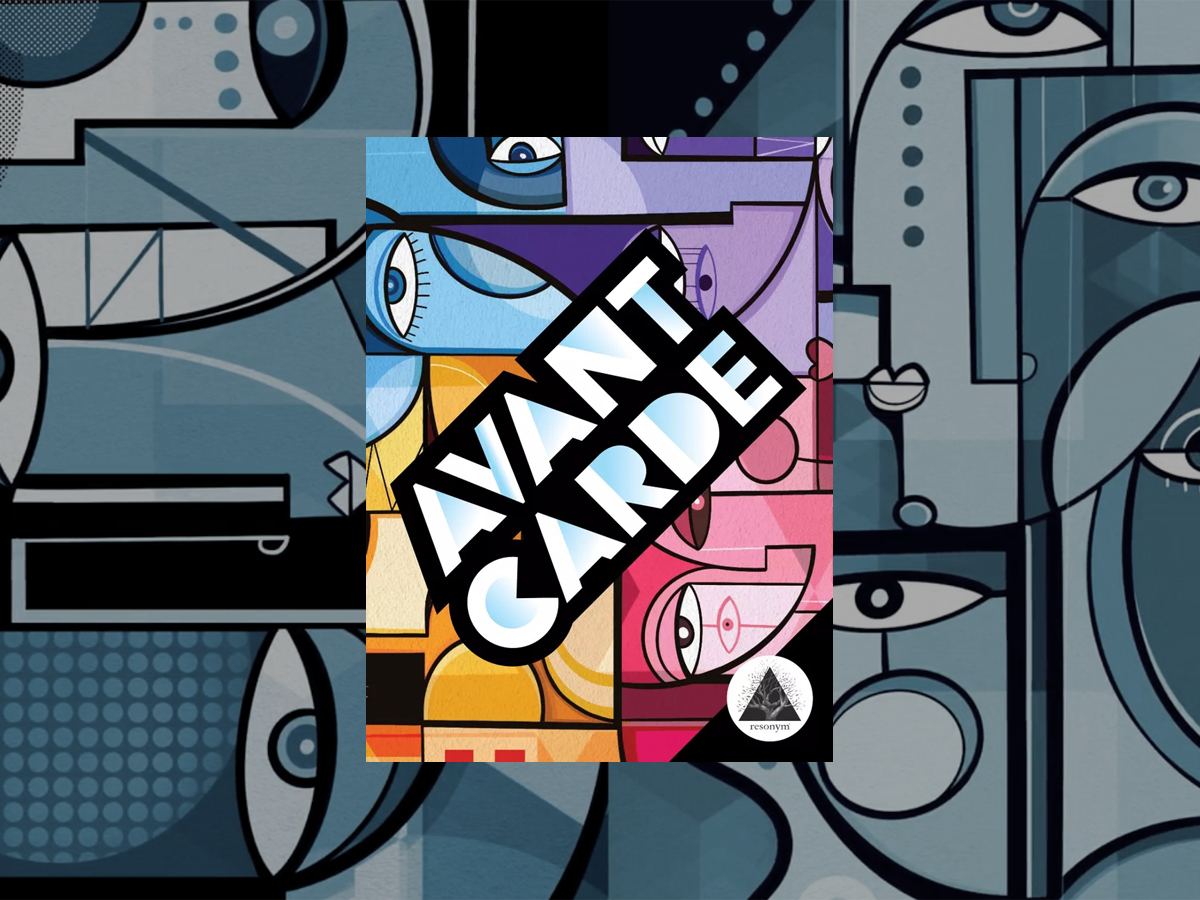Collect modern art, arrange it for an exhibition, and attract patrons to win awards!
What Is Avant Carde?
Avant Carde is a deck-building game for 1 to 5 players, ages 8 and up, and takes about 30 minutes to play. It’s currently seeking funding on Kickstarter, with a pledge level of $20 for a standard copy of the game or $29 for the Kickstarter edition that includes metal coins and a micro expansion. (There’s also a $3 print-and-play option, and a $100 Patron of the Arts tier that includes a custom wooden box.) The gameplay is mostly straightforward, but there are a few tricky rules details; I think you could play with kids as young as 8 with adult supervision.
Avant Carde was designed by Mary Flanagan and Max Seidman and published by Resonym, with illustrations by Ishita Banerjee.
New to Kickstarter? Check out our crowdfunding primer.

Avant Carde Components
Note: My review is based on a prototype copy, so it is subject to change and may not reflect final component quality.
Here’s what comes in the box:
- Gallery Card Box of 92 cards
- Starter Deck Card Box of 50 cards (10 per player)
- Patrons Card Box of 18 Patron cards
- Hidden Gem token
- 5 Change tokens
- First Player token

One of the fun features of the game is the deck boxes themselves: you open the flaps and unroll the box, and all of the cards are already sorted into their separate stacks! You do have to shuffle each stack, but it’s a nice way to keep them separated and lay out the game quickly without having to use divider cards or just group them all in one big deck. The prototype deck boxes did have some funny creases because it was made of smaller sheets of cardstock that needed taping together, but the finished product should lay flat once unfolded.

The cards all feature a sort of cubist artwork by Ishita Banerjee, abstract faces that overlap and merge in interesting ways. I like the artwork a lot, but thematically it can feel a little funny that all of the players are collecting and exhibiting artwork exclusively from a single artist, in a single style. Each card has a number between 1 and 14, as well as a color. There are four main colors, but your starting deck also includes a few grey cards that don’t match anything else; each color has a corresponding shape, making these color-blind-friendly.

The gallery cards themselves only have artwork with the color and the number, and no other text. The patron cards indicate the ability for each of the values from 2 to 7. This is a neat way to easily change up what powers are in use in a game without having to sort out a lot of specific cards each time you play. The only downside is that as you’re playing cards, you have to refer to the patron cards in the center of the table rather than being able to just look at the card in your hand.
The tokens are simple cardboard tokens—a large gem, some coins, and a face for the first player marker. The deluxe edition will include metal coins if you want an upgrade for that.
How to Play Avant Carde
You can download a copy of the rulebook here.
The Goal
The goal of the game is to win the most awards by successfully earning money during exhibitions.
Setup
Give each player a starting deck of 10 cards and then put away any unused starting decks.
Unroll the gallery card box in the center of the play area, and shuffle each of the numbered decks individually, then place them in face-up stacks. Move some of the awards cards to the “extra awards” space of the deck, based on the player count. Set the hidden gem and change tokens nearby, and give the first player token to a random player—maybe the person with the best collection of modern art.
Choose one set of patron cards and place them face-up in the center of the playing area.
Gameplay
Each round, all players will draw 7 cards from their own deck, and then simultaneously play cards in a series in front of themselves. You’re not supposed to look at what other players are doing during this phase until you’re done with your own. You play cards a little bit like Uno: you can start with any card in your hand, but then each subsequent card has to match either the color or number of the previous card. When you can’t play any more cards, discard the rest of your hand.

Cards valued from 2 to 7 have special abilities, shown on the patron cards. Depending on which patron set you used, cards may earn you extra money, let you draw more cards from your deck, or trigger other effects. Some will let you trash cards—removing them from your discard pile completely and setting them out of the game. The 2-value cards always give a bonus to whatever player(s) played the most 2s that round.
Once everyone has played their cards, players will take turns buying cards from the market, starting with the first player. You get $1 for each card you played this round, plus you may earn additional money from certain card effects. You may buy as many cards as you can afford from the market—each card’s cost is its value, so a 2 card costs $2, and so on. You may also “bury” one card during your turn, putting it on the bottom of its deck, in case you’re looking for a specific color. Cards you purchase are placed into your own personal discard pile, and then you also discard all of the cards you’ve played. If you don’t spend all of your money, you may take a change token, which can be spent as $1 in a future round—but you may only have 1 change token total.

Depending on the amount of money you earned this round, you may also win awards. Take award cards from the pile and place them in your scoring pile.
At the end of the round, the player with the fewest awards takes the hidden gem token, which is worth $1 during the buying phase of the next round. Then, everyone draws back up to 7 cards and starts a new round, passing the first player token to the next player. (Note that if you run out of cards in your deck, then you shuffle your own discard pile to make a new deck.)
Game End
If the awards stack runs out, that triggers the end of the game—finish the round, using the extra set-aside award cards as needed, until everyone has had a turn. The player with the most awards wins! (If there’s a tie, the player with a change token wins the tie—if it’s still a tie, the players share victory.)

Why You Should Play Avant Carde
My 2-second explanation of Avant Carde is that it’s Uno meets deck-building, though there’s a little more to it than that. The Uno part is when you play out your hand: you match color or number until you can’t play anything else, generally trying to play as many cards as possible—but unlike Uno, you’re the only one playing in your particular pile. With your starting deck, you’re pretty limited on what will match: you start with 11, 12, 13, and 14 that are all different colors from each other (and they won’t match any other numbers), and with your 1s and 2s there are a couple grey ones that won’t match any colors.
As you buy more cards, though, you can focus a bit: getting more cards of the same number or same color will make it easier to string together more cards in a chain. And, of course, the cards you buy may have additional powers as well—this is where we veer away from the standard Uno game and into more deck-building territory. Some let you draw more cards, which of course is the only way to play more than 7 cards in a turn. Some just earn you more money when you play them, which increases your earning without having to play more cards. Some cards even boost the effect of other cards—so they’re not as useful on their own, but let you build some powerful combos.
But it’s also important (as you might have seen in other deck-building games) to trash cards—that is, get rid of cards entirely. I’ve had some games where I eventually got rid of almost all of my starting cards, which made it more likely that every card draw would be something with an ability. (And by focusing on just a couple colors, it meant a higher likelihood that I could make a match with almost anything I drew.)

Each of the patron sets is named after a city, and I like the way that you can change up the feel of the game just by swapping out the patrons. You can even mix and match sets, so you could use the 2 from the New Yorkers, the 3 from the Parisians, and so on. Just adding another 6-card patron set opens up a lot of possibilities for play. The base game comes with 3 patron sets—New Yorkers, Parisians, and Angelenos—and the Kickstarter edition adds a 4th set, the Londoners.

Avant Carde plays pretty quickly. It can take a few rounds for somebody to get an engine going, but usually once that happens things can escalate quickly toward the end of the game. With your starting cards, you’ll occasionally hit $6 for an award but it doesn’t happen all the time. But if you build your deck right, you could play out your entire deck in a turn, earning 3 or 4 awards in a turn. (I haven’t seen anyone earn 5 awards, but that takes a whopping $17!) Since there are only 24—28 awards in the stack (before you end the game), they really start to vanish once multiple players have tuned their decks well.
I’ve had some mixed experiences with Avant Carde—one initial game felt a bit uneven, with one player running away with a strategy that seemed unbeatable, but then we tried to reproduce it and that strategy didn’t work a second time. There was an occasion where I got my engine going and was playing out my whole deck nearly every turn, and while it was pretty exciting the first time it happened, it felt a little less so (both to me and the other players) when I was earning 4 awards every round and they were still trying to set up a good deck. That said, the game ended pretty quickly after that so they didn’t have to suffer for too long!
The hidden gem is a small catch-up mechanism, giving the player in last place an extra dollar to spend—but only if there is a single player in last place. If two people are tied for last, then nobody gets the hidden gem, and that seems more likely to happen if you have more players. (I’ve mostly played with 3 and 4 players.) The extra dollar isn’t guaranteed to catch you up, either—I played one game where I had the hidden gem every round and came in dead last! But it can help, as long as you make good use of that extra $1.
While the roll-up deck boxes aren’t strictly necessary for the gameplay, I think they’re a really cool idea. I first saw them on social media when Max Seidman was tinkering with them and posting videos of different iterations, and I was really intrigued. With so many games that require you to separate out several different types of cards, I could see this box design making setup a lot easier in many instances, even if you didn’t use it as a game board (the way Avant Carde does). Here, it makes for an easy central layout to hold the gallery cards and display the patron powers. I’m curious to see if they’ll catch on beyond this game!
I always love seeing what Resonym is up to. I’ve played several of their games, and while there are a couple of common threads among a few of them (they’ve got three games that involve clues and word-guessing), many of their games are totally distinct from the others. Mechanica involves creating a factory that churns out robot vacuums; Retrograde is a Space Invaders–inspired roll-and-write with a real-time element to it; Phantom Ink is a haunted word game. It seems appropriate for them to have a game about avant garde art, given their penchant for experimentation!
Avant Carde is easy to learn because the card-chaining is familiar and it eases you into the deck-building genre if you aren’t already familiar with it, but it also adds some of its own fun quirks. The patron cards allow for both flexibility and variety, and the cards are fun to look at even though the only game information on the gallery cards is a number and a color.
For more information or to make a pledge, visit the Avant Carde Kickstarter page!
Click here to see all our tabletop game reviews.
![]() To subscribe to GeekDad’s tabletop gaming coverage, please copy this link and add it to your RSS reader.
To subscribe to GeekDad’s tabletop gaming coverage, please copy this link and add it to your RSS reader.
Disclosure: GeekDad received a prototype of this game for review purposes.





